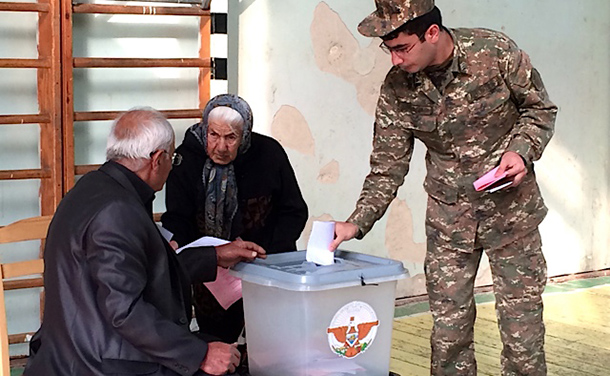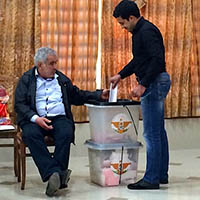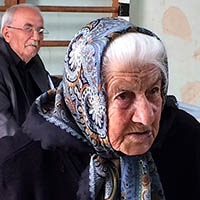
Editor’s Note: In May, 2015, Gail Pellerin, Santa Cruz County Clerk, joined other Californians as part of a University of California Election Observation and Technical Assistance Team for the sixth parliamentary election held in Nagorno-Karabakh.
The Nagorno-Karabakh Republic, aka Artsakh, is a land-locked region in Azerbaijan that is working toward being recognized as an independent country. Most of the people who live there are Armenian and the horrific devastation of the 1992 war with Azerbaijan is still fresh in their minds. The only road in and out of this country winds through the Lachin Corridor which legally belongs to the Azeris but is under control of Nagorno-Karabakh. While there is a modern airport that opened in 2012, it remains closed due to threats from Azerbaijan to shoot down any aircraft. So, the only way to get there is a six-hour car ride through the Lachin Corridor.
 On May 3, 2015 Nagorno-Karabakh conducted its sixth parliamentary election since declaring independence. Slightly more than 102,000 voters were registered to participate (roughly the number of registered voters in Yolo County in November 2014). Unlike our recent elections in California where enthusiasm and turnout have been disappointing, election excitement filled the air. Nonpartisan election banners draped the roadways from the capital city to the remote villages. Nine poll workers, all of who had undergone several days’ to a week’s worth of training, were assigned to each of the 279 polling stations. Voters we encountered were well-informed and engaged. It was especially great to see women actively serving as government officials, candidates, poll workers, party representatives, and voters.
On May 3, 2015 Nagorno-Karabakh conducted its sixth parliamentary election since declaring independence. Slightly more than 102,000 voters were registered to participate (roughly the number of registered voters in Yolo County in November 2014). Unlike our recent elections in California where enthusiasm and turnout have been disappointing, election excitement filled the air. Nonpartisan election banners draped the roadways from the capital city to the remote villages. Nine poll workers, all of who had undergone several days’ to a week’s worth of training, were assigned to each of the 279 polling stations. Voters we encountered were well-informed and engaged. It was especially great to see women actively serving as government officials, candidates, poll workers, party representatives, and voters.
There were 42 candidates registered under the majoritarian electoral system and 164 candidates from seven different political parties registered under the proportional system. Each voter received two ballots – one for each type of system. Each ballot was signed by three poll workers. One of the larger polling stations had more than 1900 voters. Imagine signing your name to 3800 ballots? That task alone would challenge even the most competent and well-trained poll worker!
Polling stations were open from 8 a.m. to 8 p.m. However, many of them were not accessible, either because there was a series of steps or they were located on a war-torn road. When I asked about accessibility for our first voter at the first polling station, the chairperson of the polls responded, “You should see where she lives!”
 The woman spoke Russian and was wrapped in her babushka, lines of a hard life radiated across her face, and she walked hunched over due to brittle bones. She seemed to be confused about how to vote and received assistance from the poll workers. Forty minutes after the polls had opened, our first voter carefully folded her ballots and inserted them into the ballot box. She shouted something to us in her hard Russian dialect. The translator explained that she was blessing us all for being there and thanked us for the opportunity to vote.
The woman spoke Russian and was wrapped in her babushka, lines of a hard life radiated across her face, and she walked hunched over due to brittle bones. She seemed to be confused about how to vote and received assistance from the poll workers. Forty minutes after the polls had opened, our first voter carefully folded her ballots and inserted them into the ballot box. She shouted something to us in her hard Russian dialect. The translator explained that she was blessing us all for being there and thanked us for the opportunity to vote.
And so our day began, with a blessing from an elderly Russian lady in a babushka! As we observed operations at other polling places, we were greeted with offers of coffee and invitations to a luncheon fully decked with china and crystal. We passed out poll worker pins from past elections in Santa Cruz County and “I voted” stickers.
On Election Day, our team and a group of Latin American observers who agreed to collect data for us visited 16 polling stations in six of Nagorno-Karabakh’s nine regions and a regional passport department that assists voters who are not on the voting list.
We visited a polling station at the country’s only prison where 17 inmates were eligible to vote. Amazingly, they had nine poll workers to staff the small Shushi prison polling station. When I asked if they could leave once all 17 had voted, I was told that the board stayed until 8 p.m. just in case someone was arrested and wanted to vote.
We contrasted that level of service afforded a potential arrestee with options available to someone who might end up in a hospital on Election Day. Unfortunately, there is no form of ballot delivery on Election Day. So, in theory, someone could shoot someone on Election Day, and the person arrested and sent to prison would be able to vote, but the victim sent to the emergency room would not.
We observed closing procedures at our final polling place. Ballots are hand counted at the polls. The ballot box, a clear plastic tub sealed with a cable tie, was opened. When the chairperson announced a vote for the Communist party, one proxy cheerfully exclaimed, “That’s my ballot!”
Voter engagement and participation was very high at every polling place we visited. In total, 70.8 percent of the people voted in the Nagorno-Karabakh election. Just to remind you, turnout among registered California voters in last year’s November election was 42 percent.
 Overall, we found the elections in Nagorno-Karabakh to be fair, transparent, secure, and accurate. I saw many similarities to our election processes in Santa Cruz County. The hope and optimism that people showed stays with me today. I’m hopeful we can restore some of that enthusiasm to our own voters.
Overall, we found the elections in Nagorno-Karabakh to be fair, transparent, secure, and accurate. I saw many similarities to our election processes in Santa Cruz County. The hope and optimism that people showed stays with me today. I’m hopeful we can restore some of that enthusiasm to our own voters.
Gail L. Pellerin is the Santa Cruz County Clerk and a member of Future of California Elections.

